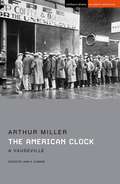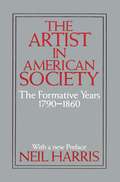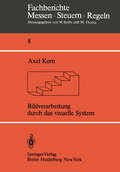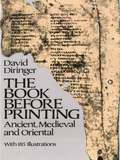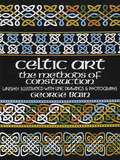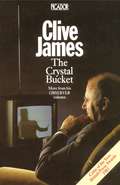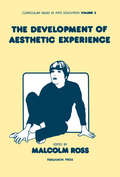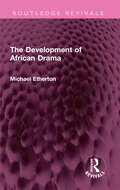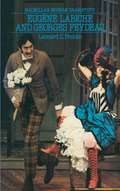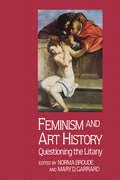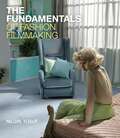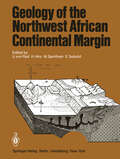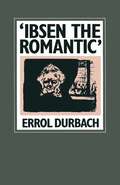- Table View
- List View
American Artists On Art: From 1940 to 1980 (PDF)
by ElIen H. JohnsonFrom the Preface: The fact that so much of modern art has devoted itself to the exploration and assertion of its own identity is reflected in, but does not explain, the increasing amount of writing and talking on the part of contemporary artists. Rather, the whole history of the changing role of art and artists in a democratic, industrial, and technological society stands behind the spate of artists' words and the public's hunger for them--even some of the general public out there beyond art's little circle. Statements by artists appeal somewhat the way drawings do: they bring us, or at least they hold the promise of bringing us, closer to the artist's thoughts and feelings and to an understanding of his or her modus operandi; they hold the keys to a mysterious realm. And sometimes they offer us the sheer pleasure of good reading. Such is the primary raison d'etre of this book.Its other motivation is educational, and stems from the frustrating lack, in teaching contemporary art, of any single compilation of statements by American artists from 1940 to the present.... This anthology differs in several respects from those others that do include documents of American art since 1940.... The selection I have made is devoted exclusively to statements of artists; it is limited to the last four decades; it presents in a single volume a representative and fairly comprehensive coverage of major developments in American art beginning with Abstract Expressionism; and, whenever possible, it cities the first, or among the very earliest, documents signalizing a shift in the definition, intent, or direction of art."
The American Clock: A Vaudeville (Student Editions)
by Arthur Miller'It is Mr. Miller's notion, potentially a great one, that the Baums' story can help tell the story of America itself during that traumatic era.'NEW YORK TIMESWhen the stock market crashes, the once-financially comfortable Baum family lose everything and are forced to leave their lofty home in Manhattan to live with relatives in Brooklyn: how can their pride, purpose and artistic endeavours survive such a sudden and shocking reversal of fortune?A sweeping, hard-hitting look at the Great Depression of the 1930s, The American Clock is a vaudevillian celebration of American resilience and optimism in the face of national crisis, and was performed on Broadway in 1980.This Methuen Drama Student Edition is edited by Jane K. Dominik, with commentary and notes that explore the play's production history (including excerpts from interviews with designers of the 1980 Broadway production) as well as the dramatic, thematic and academic debates that surround it.
Art and Eloquence in Byzantium (Princeton Legacy Library #5253)
by Henry MaguireIn this interdisciplinary study, Henry Maguire examines the influence of several literary genres and rhetorical techniques on the art of narration in Byzantium. He reveals the important and wide-reaching influence of literature on the visual arts. In particular, he shows that the literary embellishments of the sermons and hymns of the church nourished the imaginations of artists, and fundamentally affected the iconography, style, and arrangement of their work. Using provocative material previously unfamiliar to art historians, he concentrates on religious art from A.D. 843 to 1453.Professor Maguire first considers the Byzantine view of the link between oratory and painting, and then the nature of rhetoric and its relationship to Christian literature. He demonstrates how four rhetorical genres and devices—description, antithesis, hyperbole, and lament—had a special affinity with the visual arts and influenced several scenes in the Byzantine art, including the Annunciation, the Nativity, the Massacre of the Innocents, the Presentation, Christ's Passion, and the Dormition of the Virgin.Through the literature of the church, Professor Maguire concludes, the methods of rhetoric indirectly helped Byzantine artists add vividness to their narratives, structure their compositions, and enrich their work with languages. Once translated into visual language, the artifices of rhetoric could be appreciated by many.Henry Maguire is Assistant Professor of Art History at the University of Illinois at Urbana-Champaign.Originally published in 1982.The Princeton Legacy Library uses the latest print-on-demand technology to again make available previously out-of-print books from the distinguished backlist of Princeton University Press. These editions preserve the original texts of these important books while presenting them in durable paperback and hardcover editions. The goal of the Princeton Legacy Library is to vastly increase access to the rich scholarly heritage found in the thousands of books published by Princeton University Press since its founding in 1905.
Arte of Rhethorique (Routledge Revivals)
by Thomas WilsonOriginally published in 1982, this book includes The Arte of Rhetorique by Thomoas Wilson, alongisde a critical analysis by Thomoas J. Derrick. It includes chapters on biographical context, a critical introduction, and historical collation.
Arte of Rhethorique (Routledge Revivals)
by Thomas WilsonOriginally published in 1982, this book includes The Arte of Rhetorique by Thomoas Wilson, alongisde a critical analysis by Thomoas J. Derrick. It includes chapters on biographical context, a critical introduction, and historical collation.
The Artist in American Society: The Formative Years
by Neil HarrisWhat was the place of the artist in a new society? How would he thrive where monarchy, aristocracy, and an established church—those traditional patrons of painting, sculpture, and architecture—were repudiated so vigorously? Neil Harris examines the relationships between American cultural values and American society during the formative years of American art and explores how conceptions of the artist's social role changed during those years.
Biomedical Images and Computers: Selected Papers Presented at the United States-France Seminar on Biomedical Image Processing, St. Pierre de Chartreuse, France, May 27–31, 1980 (Lecture Notes in Medical Informatics #17)
by J. Sklansky J. C. BisconteThe technology of automatic pattern recognition and digital image processing, after over two decades of basic research, is now appearing in important applications in biology and medicine as weIl as industrial, military and aerospace systems. In response to a suggestion from Mr. Norman Caplan, ·the Program Director for Automation, Bioengineering and Sensing at the United States National Science Foundation, the authors of this book organized the first Uni ted States-France Seminar on Biomedical Image Processing. The seminar met at the Hotel Beau Site, St. Pierre de Chartreuse, France on May 27-31, 1980. This book contains most of the papers presented at this seminar, as weIl as two papers (by Bisconte et al. and by Ploem ~ al.) discussed at the seminar but not appearing on the program. We view the subject matter of this seminar as a confluence amon~ three broad scientific and engineering disciplines: 1) biology and medicine, 2) imaging and optics, and 3) computer science and computer engineering. The seminar had three objectives: 1) to discuss the state of the art of biomedical image processing with emphasis on four themes: microscopic image analysis, radiological image analysis, tomography, and image processing technology; 2) to place values on directions for future research so as to give guidance to agencies supporting such research; and 3) to explore and encourage various areas of cooperative research between French and Uni ted States scientists within the field of Biomedical Image Processing.
The Book Before Printing: Ancient, Medieval and Oriental
by David DiringerIt is probable that the earliest "books" were written on wood or leaves as early as the fourth millennium B.C. These fragile materials, unfortunately, have not come down to us. In their absence, the earliest surviving books are the clay tablets of Mesopotamia, the oldest attributed to c. 3500 B.C. On these ancient clay shards, dense rows of cuneiform script record the seminal writings of mankind: the Gilgamesh epic, Sumerian literary catalogues, Babylonian astrology, Assyrian accounts of the Creation and the Flood, and the Lipit-Ishtar Law-Code (c. 2000 B.C.), predating Hammurabi and the oldest law code in human history.Probably as ancient as the Mesopotamian writings, or nearly so, are Egyptian hieroglyphics. In a sense, it is the papyrus scrolls of the Egyptians -- preserved by that country's hot, dry climate -- that represent the true ancestors of the modern book. As the centuries passed, papyrus slowly gave way to parchment (the prepared skins of animals) as writing material. Indeed, the handwritten parchment or vellum codex is "the book" par excellence of the Middle Ages. Western European book production is only part of the story, and the author is at pains to illuminate the bibliographic contributions of numerous peoples and cultures: Greek and Roman book production, books made in central and southern Asia, the books of Africa, pre-Columbian America, and the Far East -- material that is often not mentioned in Western histories of the book.Based on years of painstaking research and incorporating a wealth of new material and conclusions, the text is enhanced throughout by abundant illustrations -- nearly 200 photographic facsimiles of priceless manuscripts in museums and libraries around the world.
Celtic Art: The Methods of Construction
by George BainThe construction principles of Celtic art were re-discovered in the middle of the 20th century by George Bain. Until his writing, the intricate knots, interlacings, and spirals used in illuminating The Book of Kells and in decorating craftwork and jewelry seemed almost impossible, "the work of angels." In this pioneering work, George Bain shows how simple principles, no more difficult than those used in needlecraft, were used to create some of the finest artistic works ever seen. He also explains how you can use these principles in re-creating artifacts and in creating your own Celtic designs for art and craft work or even for recreational use.Step-by-step procedures carefully introduce the simple rules and methods of Celtic knot work and the well-known designs from the great manuscripts and stone work. Later chapters build up to complex knot work, spiral work, and key pattern designs, with special coverage of alphabets and the stylized use of animals, humans, and plants. Altogether over 225 different patterns are presented for your use, with hundreds of modification suggestions, 110 historical and modern artifacts showing designs in use, a great number of letters including six complete alphabets and 25 decorative initials, and a number of animal and human figures used in the original Celtic works.Artists, students, craftspeople, even children can work with these patterns and instructions for creating dynamic designs for use in leather work, in embroidery and other needle work, in metalwork, jewelry making, card design, borders, panels, illuminations, and in countless other ways. Mathematicians will find a great deal of pleasure in the geometric principles on which the patterns are based. Art historians and others interested in studying Celtic art will find a great number of outstanding art works and the best presentation in English for understanding Celtic design.
A Corpus of Rembrandt Paintings: 1625–1631 (Rembrandt Research Project Foundation #1)
by J. Bruyn B. Haak S.H. Levie P.J.J. van ThielSince the second half of the last century art historians, realizing that the image of Rembrandt’s work had become blurred with time, have attempted to redefine the artist’s significance both as a source of inspiration to other artists and as a great artist in his own right. In order to carry on the work started by previous generations, a group of leading Dutch art historians from the university and museum world joined forces in the late 1960s in order to study afresh the paintings usually ascribed to the artist. The researchers came together in the Rembrandt Research Project which was established to provide the art world with a new standard reference work which would serve the community of art historians for the nearby and long future. They examined the originals of all works attributed to Rembrandt taking full advantage of today’s sophisticated techniques including radiography, neutron activation autoradiography, dendrochronology and paint sample analysis — thereby gaining valuable insight into the genesis and condition of the paintings. The result of this meticulous research is laid down chronologically in the following Volumes: THIS VOLUME: A Corpus of Rembrandt Paintings, Volume I, which deals with works from Rembrandt’s early years in Leiden(1629-1631), published in 1982. A Corpus of Rembrandt Paintings, Volume II, covering his first years in Amsterdam (1631-1634), published in 1986. A Corpus of Rembrandt Paintings, Volume III, goes into his later years of reputation (1635-1642), published in 1990. Each Volume consists of a number of Introductory Chapters as well as the full Catalogue of all paintings from the given time period attributed to Rembrandt. In this catalogue each painting is discussed and examined in a detailed way, comprising a descriptive, an interpretative and a documentary section. For the authenticity evaluation of the paintings three different categories are used to divide the works in: A. Paintings by Rembrandt, B. Paintings of which Rembrandt’s authorship cannot be positively either accepted or rejected, and C. Paintings of which Rembrandt’s authorship cannot be accepted. This volume (Volume I) contains 730 pages, starting of with four introductory chapters and discussing 93 paintings. In clear and accessible explanatory text all different paintings are discussed, larded with immaculate images of each painting. Details are shown where possible, as well as the results of modern day technical imaging. In this volume the first ever works by Rembrandt are discussed, also using his etchings as comparison.
The Crystal Bucket: Television Criticism From The Observer, 1976-79 (Picador Bks.)
by Clive JamesThe second instalment in Clive James’s TV criticism collection – The Crystal Bucket - earned him the title ‘Critic of the Year’ by the British Press Awards. Taking its title from Walter Raleigh’s The Passionate Man’s Pilgrimage and is dedicated to the poet Peter Porter.
Decorative Plant and Flower Studies: For Artists and Craftsmen
by J. Foord88 royalty-free drawings of 40 plants and flowers -- Daffodil, Apple and other more or less familiar species -- distinguished by their grace, impeccable draftsmanship, and botanical accuracy. Extensive texts include botanical history, peculiar characteristics, folklore, poetic renderings, and more. An artist's sourcebook imbued with the spirit of poetry!
The Development of Aesthetic Experience: Curriculum Issues in Arts Education
by Malcolm RossCurriculum Issues in Arts Education, Volume 3: The Development of Aesthetic Experience focuses on the processes, methodologies, and approaches involved in the development of aesthetic experience, including art education, developmental theories, and aesthetic assessment. The book first tackles the concept of aesthetic development and aesthetic dimension in art education. The text then explores the psychological viewpoint of aesthetic development and aesthetic development in music. Topics include music education, music and function, task of teachers, developmental relationships between processes or roles, and uses and misuses of developmental theories.The publication ponders on the role of teachers and students, aesthetic development in dance, and drama as learning, art, and aesthetic experience. The manuscript then examines emotional development in adolescence, meaning in aesthetic experience, and aesthetic assessment and the reliability factor.The book is a reliable source of information for educators and readers interested in the development of aesthetic experience.
The Development of African Drama (Routledge Revivals)
by Michael EthertonOriginally published in 1982, this book explores concepts such as ‘traditional performance’ and African theatre’. It analyses the links between drama and ritual, and drama and music and diagnoses the confusions in our thought. The reader is reminded that drama is never merely the printed word, but that its existence as literature and in performance is necessarily different. The analysis shows that literature tends to replace performance; and drama, removed from the popular domain, becomes elitist. The book’s richness lies in the constantly stimulating analysis of ‘art’ theatre, as exemplified in protest plays, in African adaptations and transpositions of such classical subjects as the Bacchae and Everyman, in plays on African history, on colonialism and neo-colonialism. The final chapters argue that the form of African drama needs to evolve as the content does.
The Development of African Drama (Routledge Revivals)
by Michael EthertonOriginally published in 1982, this book explores concepts such as ‘traditional performance’ and African theatre’. It analyses the links between drama and ritual, and drama and music and diagnoses the confusions in our thought. The reader is reminded that drama is never merely the printed word, but that its existence as literature and in performance is necessarily different. The analysis shows that literature tends to replace performance; and drama, removed from the popular domain, becomes elitist. The book’s richness lies in the constantly stimulating analysis of ‘art’ theatre, as exemplified in protest plays, in African adaptations and transpositions of such classical subjects as the Bacchae and Everyman, in plays on African history, on colonialism and neo-colonialism. The final chapters argue that the form of African drama needs to evolve as the content does.
Digital Picture Processing (Computer Science and Applied Mathematics #Volume 1)
by Azriel Rosenfeld Avinash C. KakThe rapid rate at which the field of digital picture processing has grown in the past five years had necessitated extensive revisions and the introduction of topics not found in the original edition.
Erzeugung interaktiver Bildverarbeitungssysteme im Dialog: Konzepte, Entwurf und Implementierung eines Dialogsystems für die Bildverarbeitung in der Medizin (Informatik-Fachberichte #51)
by G. PfeifferFashion and Fetishism: Corsets, Tight-Lacing & Other Forms of Body-Sculpture (Penguin Classics Ser.)
by David KunzlePresenting the history of corsetry and body sculpture, this edition shows how the relationship between fashion and sex is closely bound up with sexual self-expression. It demonstrates how the use of the corset rejected the role of the passive, maternal woman, so that in Victorian times it was seen as a scandalous threat to the social order.
Feminism And Art History: Questioning The Litany
by Norma BroudeA long-needed corrective and alternative view of Western art history, these seventeen essays by respected scholars are arranged chronologically and cover every major period from the ancient Egyptian to the present. While several of the essays deal with major women artists, the book is essentially about Western art history and the extent to which it has been distorted, in every period, by sexual bias. With 306 illustrations.
Feminism And Art History: Questioning The Litany (Icon Editions Ser.)
by Norma BroudeA long-needed corrective and alternative view of Western art history, these seventeen essays by respected scholars are arranged chronologically and cover every major period from the ancient Egyptian to the present. While several of the essays deal with major women artists, the book is essentially about Western art history and the extent to which it has been distorted, in every period, by sexual bias. With 306 illustrations.
The Fundamentals of Fashion Filmmaking (Fundamentals)
by Nilgin YusufOver the last decade fashion film's presence has become ubiquitous. From the retail environments where fashion film is projected onto windows and buildings, to the online arenas of fashion brands and labels through to art gallery installations, fashion communication is on the move.With examples from dozens of groundbreaking international films, including QR codes linking to the films online, The Fundamentals of Fashion Filmmaking places fashion film in its broader industry, cultural and historical context. You'll also learn about the process of making fashion film, exploring how it works across multiple technologies, platforms and audiences. Interviews with filmmakers bring together a wealth of industry expertise on everything from storyboarding to finding an audience.

